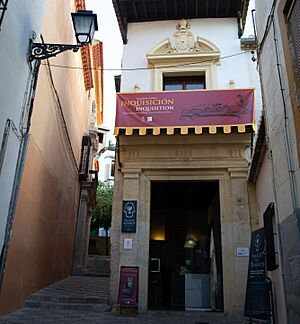Palace of the Forgotten facts for kids
The Palace of the Forgotten (in Spanish, Palacio de los Olvidados) is a museum in Granada, Spain. It teaches visitors about the Spanish Inquisition and the history of Granada and Andalusia. The museum is in the Albaicín neighborhood, which is a World Heritage Site recognized by UNESCO. This area is an important part of the historic complex that includes the Alhambra and the Generalife.
The museum is located in a beautiful old building called the Casa-Palacio de Santa Inés. This palace was built in the 1500s and has been carefully restored. It is considered a special heritage site. On the front of the building, there is an old coat of arms. Experts believe it might have belonged to a Jewish person who converted to Christianity. This person wanted to show their family's "pure blood" status, which was important at that time. The museum first opened its doors in 2014. You can also book guided tours to learn even more.
Contents
What You Can See at the Museum
The museum has over 7,500 square feet (700 square meters) of space for its exhibits. From its terraces, you can enjoy amazing views of the Alhambra and the Albaicín. The museum currently has two main exhibitions: "Inquisition: Ancient Instruments of Torture" and "Interactive Flamenco."
A Look Back at History
Long ago, a large Jewish community lived in Granada. They were important poets, leaders, scientists, and thinkers. They helped make Granada a rich and vibrant city. Today, not many signs of this Jewish community remain.
The Palace of the Forgotten was created to show the history of the Sephardic culture in Granada. "Sephardic" refers to Jewish people from Spain and Portugal. The museum's name, "Palace of the Forgotten," reminds us of the Jewish people who were forced to leave Granada by the Catholic Monarchs during the Inquisition. The museum aims to fill this gap in history and teach people about the Jewish presence in the city.
The Museum's Collections
The museum displays parts of its original building along with items from private collections. Many pieces come from the Crespo López Family collection. These items are spread across two floors. They include objects related to the Inquisition, Jewish converts, religious symbols, and special items used in Jewish ceremonies and celebrations.
The museum also highlights the important role of women in Sephardic culture. It features famous Jewish figures like Samuel ibn Naghrillah, Moses ibn Ezra, and Judah ibn Tibbon. Your visit ends in a room dedicated to the Water Synagogue in Úbeda. This room even has a recreated ritual bath, called a Mikveh.
The museum shows how the Inquisition affected the daily lives of Jewish people in Granada. Historical tools from the Inquisition are displayed alongside symbols of Sephardic culture. This helps visitors understand both the difficult times and the rich history of Jewish people in Spain.
The Inquisition Exhibit
The Spanish Inquisition was started by the Catholic Monarchs in 1478. Its goal was to make sure everyone in Spain was Catholic. It lasted for about 350 years, finally ending in 1834.
The Palace of the Forgotten displays more than 70 historical tools. These tools were used by the Inquisition courts in Europe and Spain. As you walk through the exhibit, soft music plays. The displays include a skeleton tied to a wheel and a sanbenito (a special garment worn by those punished by the Inquisition). These items help tell the story of this challenging period in history.
The Interactive Flamenco Exhibit
On the first floor, you'll find the Interactive Flamenco exhibition. This exhibit is designed to help you experience the many feelings that flamenco music and dance create. You can learn about flamenco's past and present, its rhythms, beats, and different types of voices. It's a "living museum" where you can take part and use interactive screens to explore flamenco's dances and influences.
See also
 In Spanish: Palacio de los Olvidados para niños
In Spanish: Palacio de los Olvidados para niños


